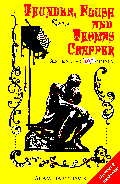Thunder, Flush and Thomas Crapper: V
^UP^ to Thunder, Flush and Thomas Crapper index.
Chapters: A B C D E F G H I J K L M N O P R S T U V W Y Z

Extracts from Adam Hart-Davis's book.
(Buy the book from Micheal O'Mara Books, ISBN 1-85479-250-4, hardback 1-85479-245-8, or in the US, ISBN 1570760810.)
- Vespasian
-
There was a considerable Roman trade in urine, which was collected
in pots on street corners and used for stiffening and dyeing cloth.
The Emperor Vespasian (AD 69--79) imposed a tax on the use of public
urinals, which became known as Vespasiani. When one of his sons
complained about the tax, the Emperor held up a coin, and asked
"Does it smell?" Later the pissoirs in France were
called Vespasiennes in his honour!
According to Suetonius, the court jester said of Vespasian's miserable expression that even when he was at his merriest he looked "as if he had been wringing hard on a close stool."
- Vietnam
-
In the late 1950s the people of Quang Ngai
Province in Vietnam responded to government initiative by
developing a double-vault latrine. These are built above
ground, at least 10 metres away from houses, where possible.
For about two months the family uses vault one, covering each
deposit with a sprinkling of ashes or dry earth. Urine is
collected in a separate pot; so the vault remains fairly dry.
(See diagram p150 of book.)
Meanwhile vault two is sealed with a lid on top. After two months the old excrement, now turned to compost, is removed from vault two, the lid is moved to vault one, and the family moves across.
The safe, odourless compost makes excellent fertilizer; according to the Ministry of Health, experiments in agricultural co-operatives show it can increase the yield of crops by 10--25 per cent (10%--25%).
See also composting lavatories, earth-closets, India, Moule, pit latrines.
- Vitreous China
-
 Most lavatory pans are made of vitreous china, which became economically
viable in the building boom after the Second World War. Before then the
clay shape was made and fired to make glost; this was glazed, then fired
again. This was an expensive process, and the glaze was always subject to
crazing. The material was called biscuit-ware, either because it broke
like a biscuit, or perhaps from the French biscuit, meaning 'twice
cooked', or twice-fired.
Most lavatory pans are made of vitreous china, which became economically
viable in the building boom after the Second World War. Before then the
clay shape was made and fired to make glost; this was glazed, then fired
again. This was an expensive process, and the glaze was always subject to
crazing. The material was called biscuit-ware, either because it broke
like a biscuit, or perhaps from the French biscuit, meaning 'twice
cooked', or twice-fired.
Vitreous china is made from ball clay, china clay, silica, and fluxing agent. Its great advantage is that the clay body and the glaze body are compatible, which means that they can be fired together, because they both expand and contract by the same amount in the kiln (see how to make a loo).
The glaze is not strictly needed for hyigene, because in the kiln the clay vitrifies---turns to an impervious glassy solid---so the whole thickness of vitreous china is waterproof and stainproof, and will not burn, rot or rust. The surface cannot craze, and is inhospitable to bacteria.
Text extracts from "Thunder, Flush and Thomas Crapper" copyright (c) Adam Hart-Davis 1997. Web extracts first published 2007-07-18, updated ✎2018-02-25
Images available from the DHD Multimedia Gallery.
Site content copyright (c) Damon Hart-Davis 1997--2018 unless otherwise stated.
Hosted by ExNet.